Cellular Communication: Cell Splitting, Channel Allocation, Design
VerifiedAdded on 2023/04/20
|9
|1353
|471
Report
AI Summary
This report provides an overview of cellular communication concepts, focusing on cell splitting techniques and network design proposals. It begins by explaining the phenomenon of cell splitting, where overcrowded cells are divided into smaller cells with reduced transmission power to increase ...
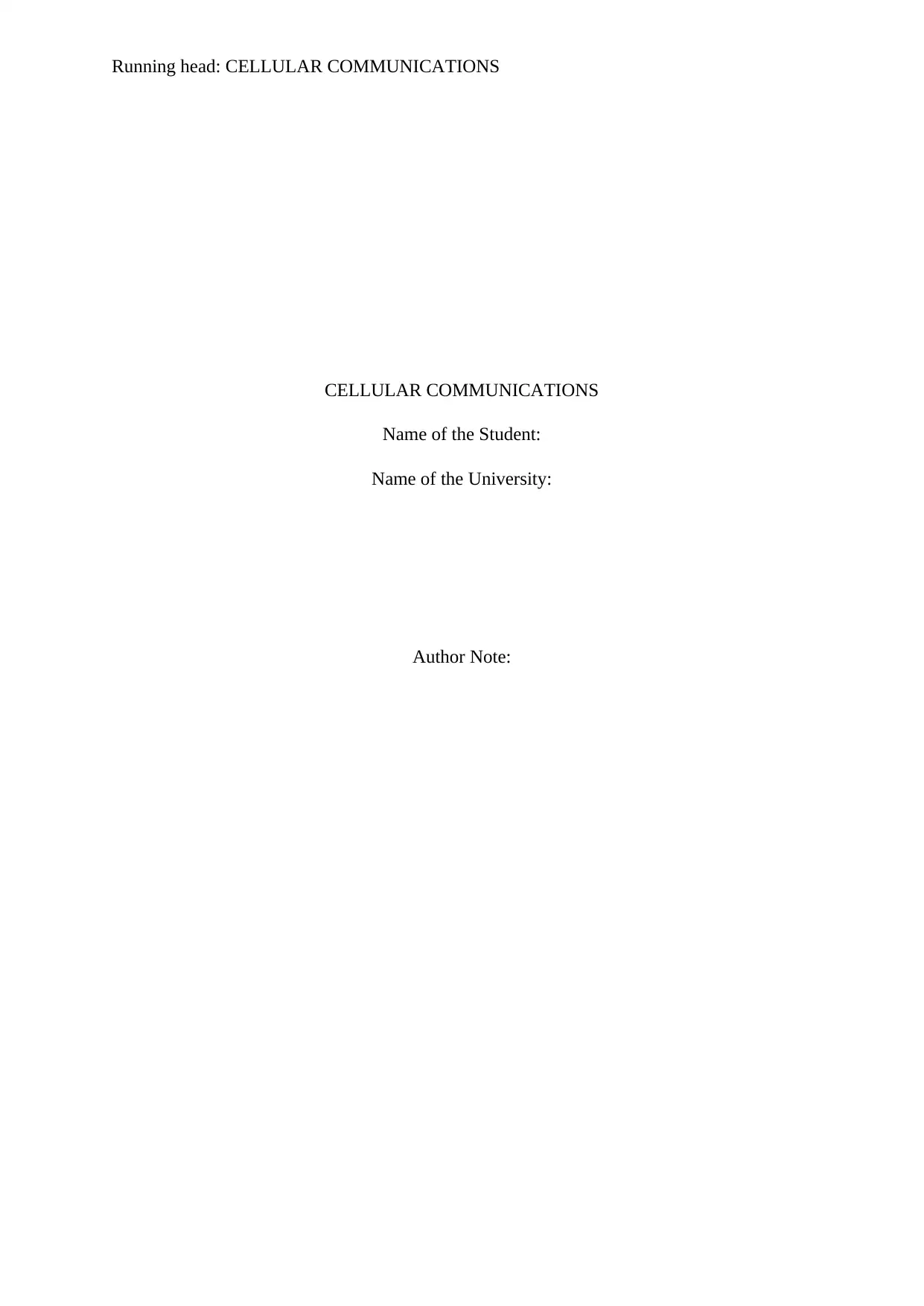
Running head: CELLULAR COMMUNICATIONS
CELLULAR COMMUNICATIONS
Name of the Student:
Name of the University:
Author Note:
CELLULAR COMMUNICATIONS
Name of the Student:
Name of the University:
Author Note:
Paraphrase This Document
Need a fresh take? Get an instant paraphrase of this document with our AI Paraphraser
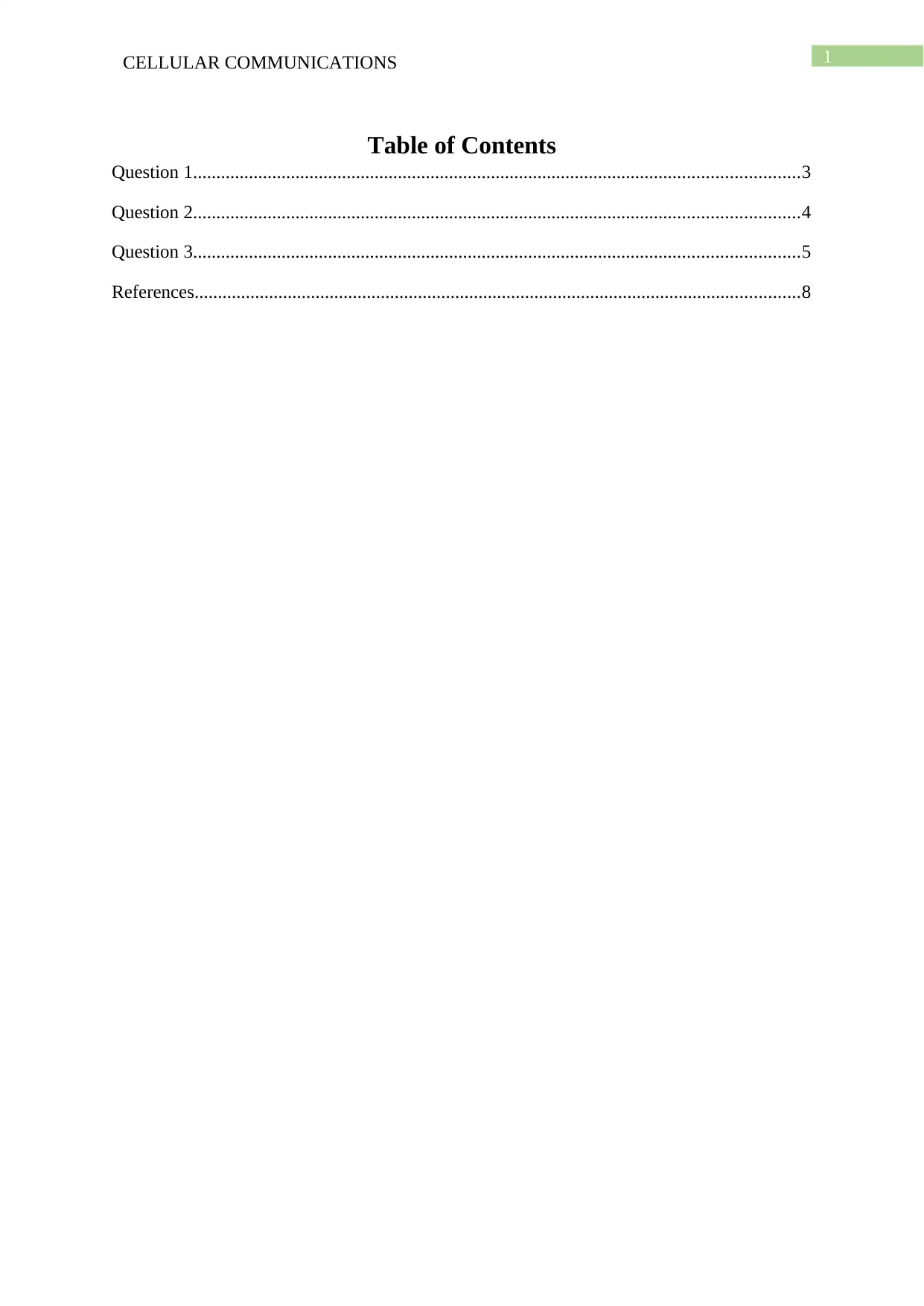
1CELLULAR COMMUNICATIONS
Table of Contents
Question 1..................................................................................................................................3
Question 2..................................................................................................................................4
Question 3..................................................................................................................................5
References..................................................................................................................................8
Table of Contents
Question 1..................................................................................................................................3
Question 2..................................................................................................................................4
Question 3..................................................................................................................................5
References..................................................................................................................................8
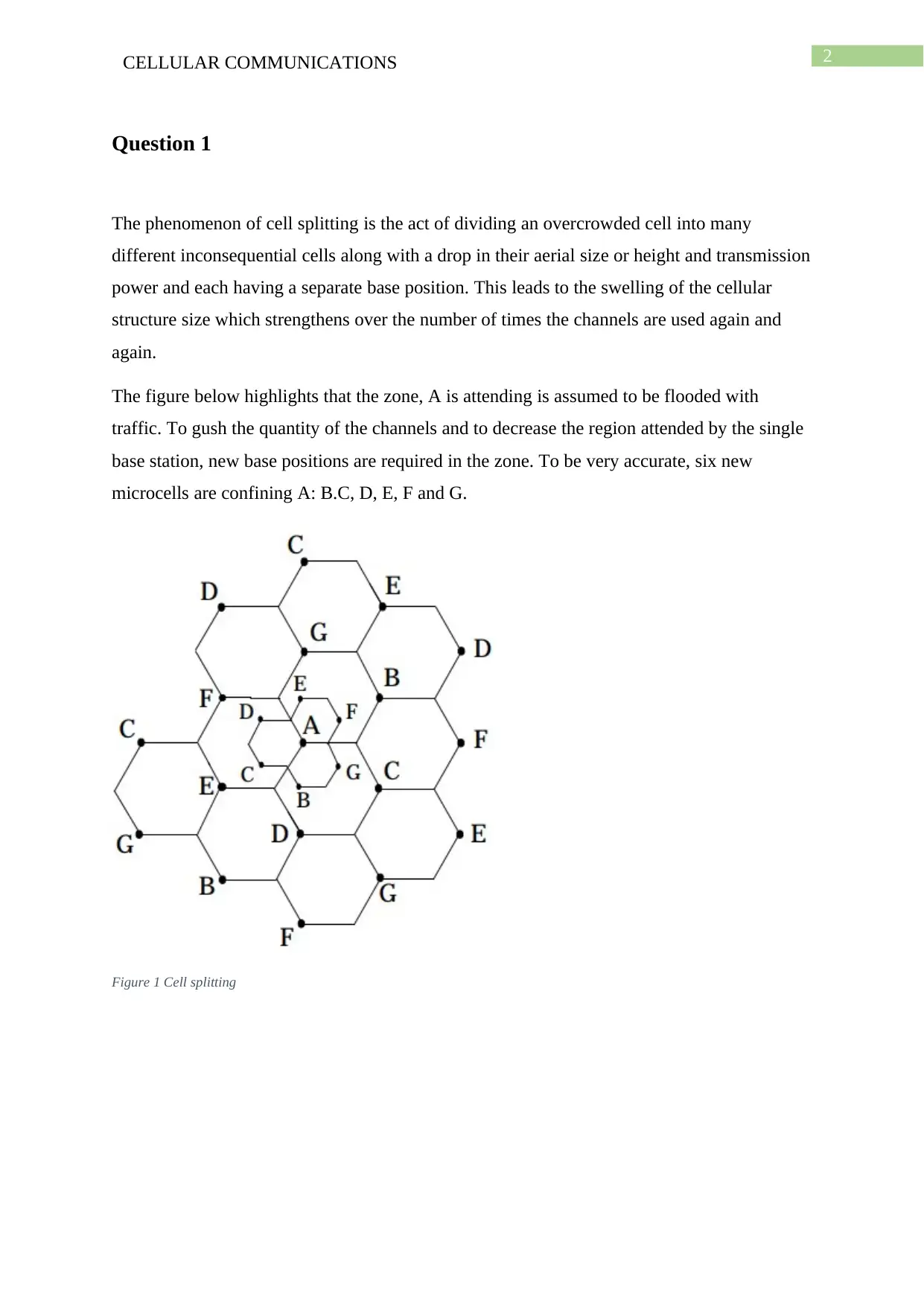
2CELLULAR COMMUNICATIONS
Question 1
The phenomenon of cell splitting is the act of dividing an overcrowded cell into many
different inconsequential cells along with a drop in their aerial size or height and transmission
power and each having a separate base position. This leads to the swelling of the cellular
structure size which strengthens over the number of times the channels are used again and
again.
The figure below highlights that the zone, A is attending is assumed to be flooded with
traffic. To gush the quantity of the channels and to decrease the region attended by the single
base station, new base positions are required in the zone. To be very accurate, six new
microcells are confining A: B.C, D, E, F and G.
Figure 1 Cell splitting
Question 1
The phenomenon of cell splitting is the act of dividing an overcrowded cell into many
different inconsequential cells along with a drop in their aerial size or height and transmission
power and each having a separate base position. This leads to the swelling of the cellular
structure size which strengthens over the number of times the channels are used again and
again.
The figure below highlights that the zone, A is attending is assumed to be flooded with
traffic. To gush the quantity of the channels and to decrease the region attended by the single
base station, new base positions are required in the zone. To be very accurate, six new
microcells are confining A: B.C, D, E, F and G.
Figure 1 Cell splitting
⊘ This is a preview!⊘
Do you want full access?
Subscribe today to unlock all pages.

Trusted by 1+ million students worldwide
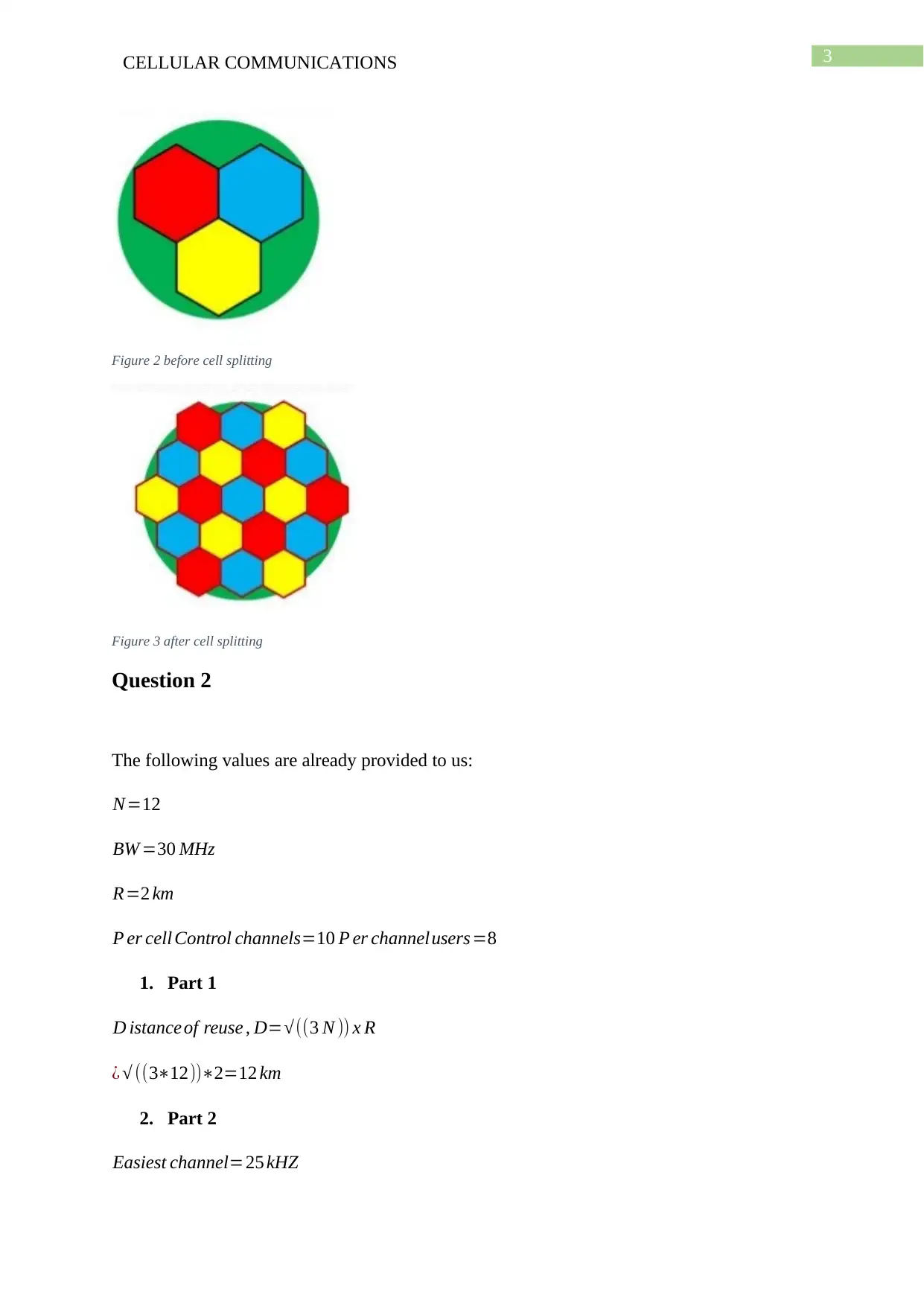
3CELLULAR COMMUNICATIONS
Figure 2 before cell splitting
Figure 3 after cell splitting
Question 2
The following values are already provided to us:
N=12
BW =30 MHz
R=2 km
P er cell Control channels=10 P er channelusers=8
1. Part 1
D istance of reuse , D=√((3 N )) x R
¿ √ ((3∗12))∗2=12 km
2. Part 2
Easiest channel=25 kHZ
Figure 2 before cell splitting
Figure 3 after cell splitting
Question 2
The following values are already provided to us:
N=12
BW =30 MHz
R=2 km
P er cell Control channels=10 P er channelusers=8
1. Part 1
D istance of reuse , D=√((3 N )) x R
¿ √ ((3∗12))∗2=12 km
2. Part 2
Easiest channel=25 kHZ
Paraphrase This Document
Need a fresh take? Get an instant paraphrase of this document with our AI Paraphraser
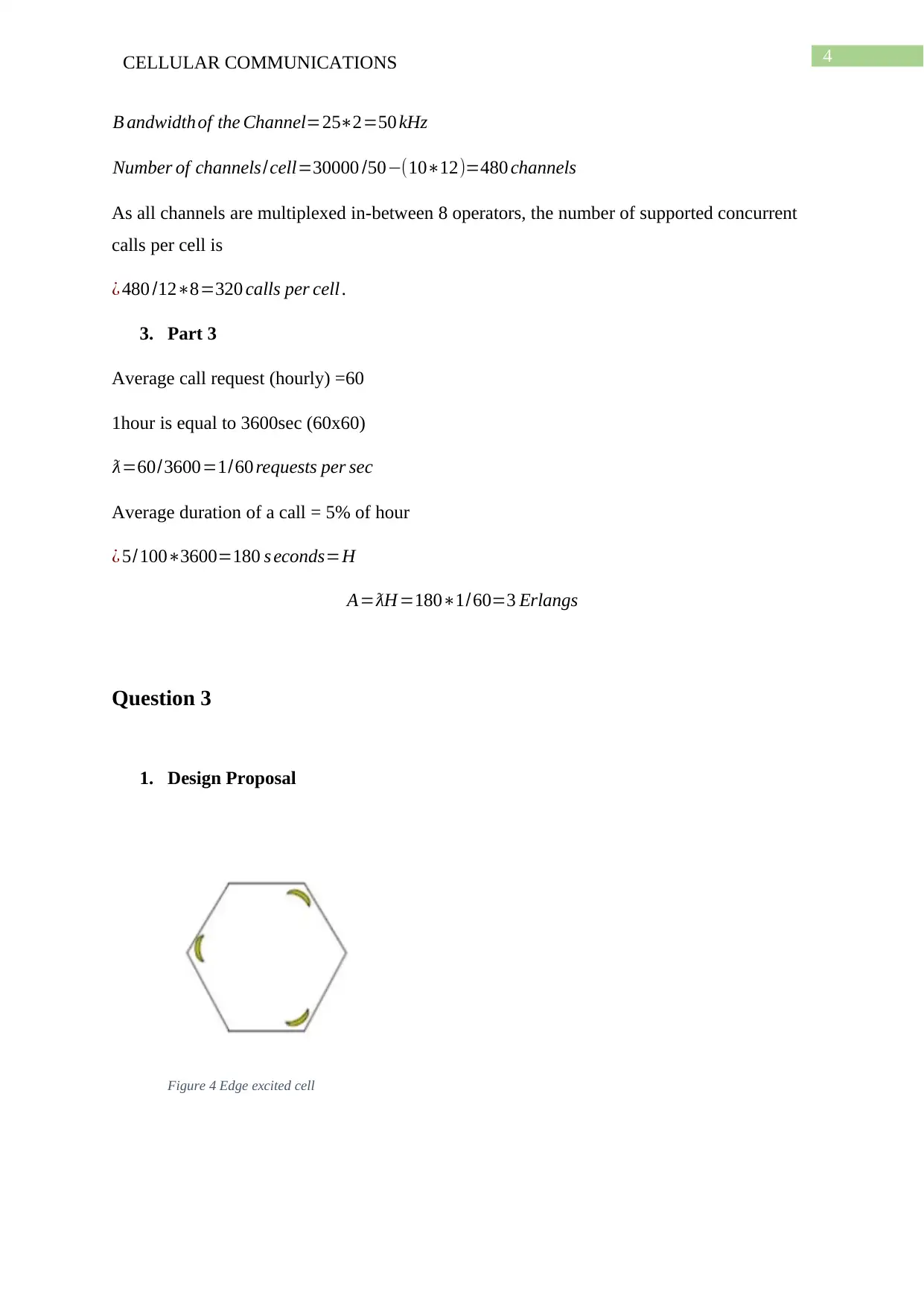
4CELLULAR COMMUNICATIONS
B andwidth of the Channel=25∗2=50 kHz
Number of channels/cell=30000 /50−(10∗12)=480 channels
As all channels are multiplexed in-between 8 operators, the number of supported concurrent
calls per cell is
¿ 480 /12∗8=320 calls per cell .
3. Part 3
Average call request (hourly) =60
1hour is equal to 3600sec (60x60)
ƛ=60/3600=1/60 requests per sec
Average duration of a call = 5% of hour
¿ 5/100∗3600=180 s econds=H
A=ƛH =180∗1/60=3 Erlangs
Question 3
1. Design Proposal
Figure 4 Edge excited cell
B andwidth of the Channel=25∗2=50 kHz
Number of channels/cell=30000 /50−(10∗12)=480 channels
As all channels are multiplexed in-between 8 operators, the number of supported concurrent
calls per cell is
¿ 480 /12∗8=320 calls per cell .
3. Part 3
Average call request (hourly) =60
1hour is equal to 3600sec (60x60)
ƛ=60/3600=1/60 requests per sec
Average duration of a call = 5% of hour
¿ 5/100∗3600=180 s econds=H
A=ƛH =180∗1/60=3 Erlangs
Question 3
1. Design Proposal
Figure 4 Edge excited cell
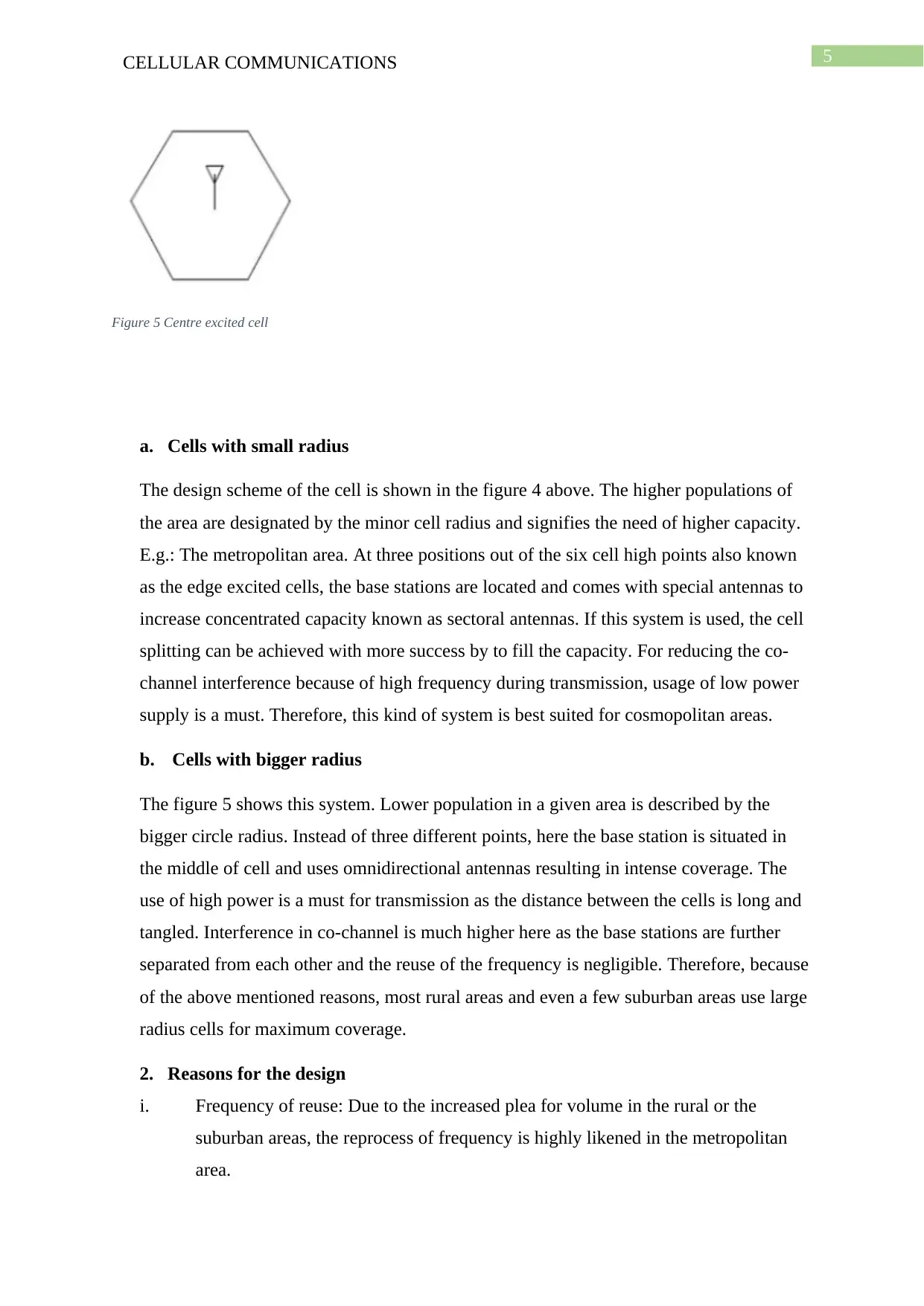
5CELLULAR COMMUNICATIONS
Figure 5 Centre excited cell
a. Cells with small radius
The design scheme of the cell is shown in the figure 4 above. The higher populations of
the area are designated by the minor cell radius and signifies the need of higher capacity.
E.g.: The metropolitan area. At three positions out of the six cell high points also known
as the edge excited cells, the base stations are located and comes with special antennas to
increase concentrated capacity known as sectoral antennas. If this system is used, the cell
splitting can be achieved with more success by to fill the capacity. For reducing the co-
channel interference because of high frequency during transmission, usage of low power
supply is a must. Therefore, this kind of system is best suited for cosmopolitan areas.
b. Cells with bigger radius
The figure 5 shows this system. Lower population in a given area is described by the
bigger circle radius. Instead of three different points, here the base station is situated in
the middle of cell and uses omnidirectional antennas resulting in intense coverage. The
use of high power is a must for transmission as the distance between the cells is long and
tangled. Interference in co-channel is much higher here as the base stations are further
separated from each other and the reuse of the frequency is negligible. Therefore, because
of the above mentioned reasons, most rural areas and even a few suburban areas use large
radius cells for maximum coverage.
2. Reasons for the design
i. Frequency of reuse: Due to the increased plea for volume in the rural or the
suburban areas, the reprocess of frequency is highly likened in the metropolitan
area.
Figure 5 Centre excited cell
a. Cells with small radius
The design scheme of the cell is shown in the figure 4 above. The higher populations of
the area are designated by the minor cell radius and signifies the need of higher capacity.
E.g.: The metropolitan area. At three positions out of the six cell high points also known
as the edge excited cells, the base stations are located and comes with special antennas to
increase concentrated capacity known as sectoral antennas. If this system is used, the cell
splitting can be achieved with more success by to fill the capacity. For reducing the co-
channel interference because of high frequency during transmission, usage of low power
supply is a must. Therefore, this kind of system is best suited for cosmopolitan areas.
b. Cells with bigger radius
The figure 5 shows this system. Lower population in a given area is described by the
bigger circle radius. Instead of three different points, here the base station is situated in
the middle of cell and uses omnidirectional antennas resulting in intense coverage. The
use of high power is a must for transmission as the distance between the cells is long and
tangled. Interference in co-channel is much higher here as the base stations are further
separated from each other and the reuse of the frequency is negligible. Therefore, because
of the above mentioned reasons, most rural areas and even a few suburban areas use large
radius cells for maximum coverage.
2. Reasons for the design
i. Frequency of reuse: Due to the increased plea for volume in the rural or the
suburban areas, the reprocess of frequency is highly likened in the metropolitan
area.
⊘ This is a preview!⊘
Do you want full access?
Subscribe today to unlock all pages.

Trusted by 1+ million students worldwide
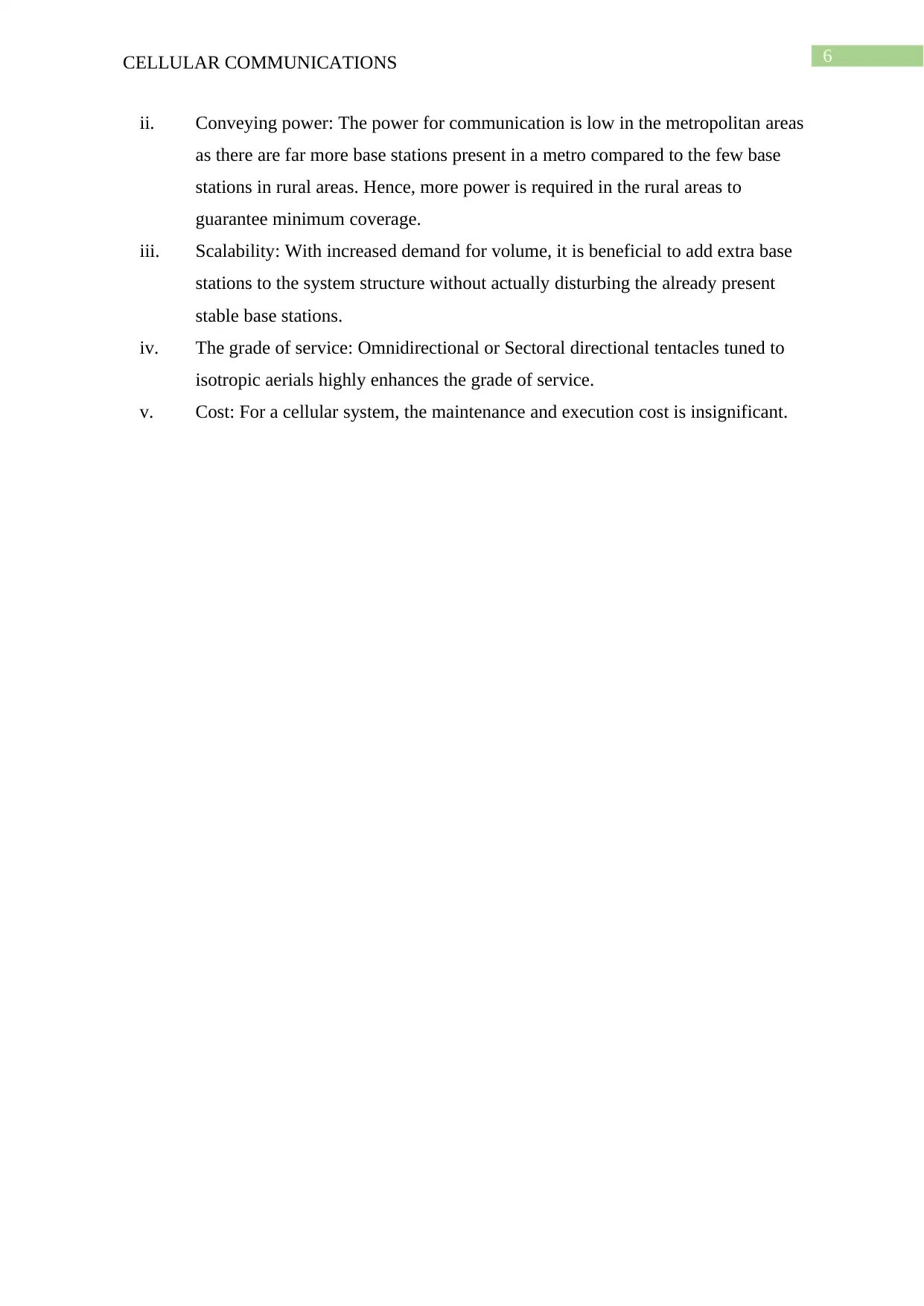
6CELLULAR COMMUNICATIONS
ii. Conveying power: The power for communication is low in the metropolitan areas
as there are far more base stations present in a metro compared to the few base
stations in rural areas. Hence, more power is required in the rural areas to
guarantee minimum coverage.
iii. Scalability: With increased demand for volume, it is beneficial to add extra base
stations to the system structure without actually disturbing the already present
stable base stations.
iv. The grade of service: Omnidirectional or Sectoral directional tentacles tuned to
isotropic aerials highly enhances the grade of service.
v. Cost: For a cellular system, the maintenance and execution cost is insignificant.
ii. Conveying power: The power for communication is low in the metropolitan areas
as there are far more base stations present in a metro compared to the few base
stations in rural areas. Hence, more power is required in the rural areas to
guarantee minimum coverage.
iii. Scalability: With increased demand for volume, it is beneficial to add extra base
stations to the system structure without actually disturbing the already present
stable base stations.
iv. The grade of service: Omnidirectional or Sectoral directional tentacles tuned to
isotropic aerials highly enhances the grade of service.
v. Cost: For a cellular system, the maintenance and execution cost is insignificant.
Paraphrase This Document
Need a fresh take? Get an instant paraphrase of this document with our AI Paraphraser
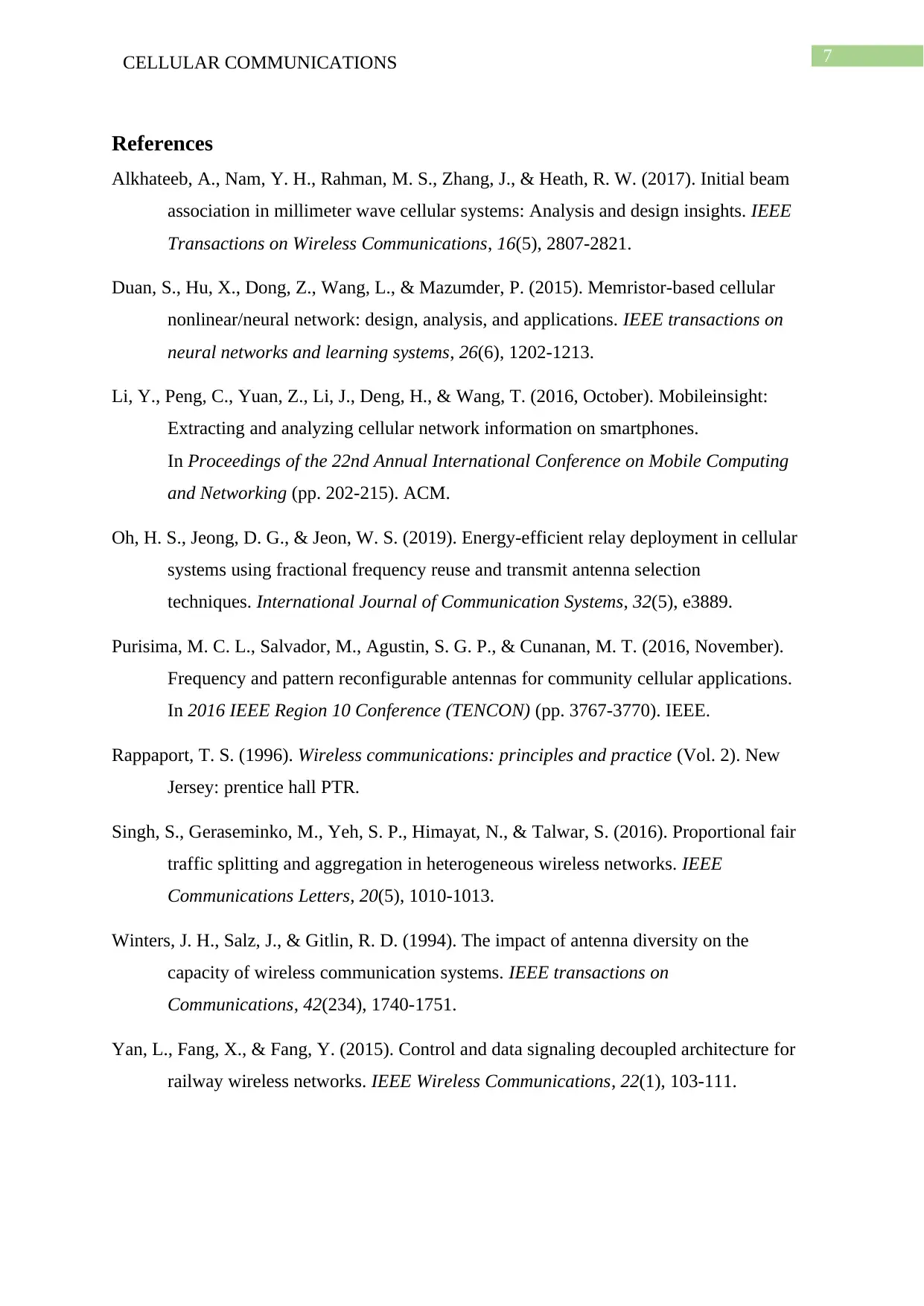
7CELLULAR COMMUNICATIONS
References
Alkhateeb, A., Nam, Y. H., Rahman, M. S., Zhang, J., & Heath, R. W. (2017). Initial beam
association in millimeter wave cellular systems: Analysis and design insights. IEEE
Transactions on Wireless Communications, 16(5), 2807-2821.
Duan, S., Hu, X., Dong, Z., Wang, L., & Mazumder, P. (2015). Memristor-based cellular
nonlinear/neural network: design, analysis, and applications. IEEE transactions on
neural networks and learning systems, 26(6), 1202-1213.
Li, Y., Peng, C., Yuan, Z., Li, J., Deng, H., & Wang, T. (2016, October). Mobileinsight:
Extracting and analyzing cellular network information on smartphones.
In Proceedings of the 22nd Annual International Conference on Mobile Computing
and Networking (pp. 202-215). ACM.
Oh, H. S., Jeong, D. G., & Jeon, W. S. (2019). Energy‐efficient relay deployment in cellular
systems using fractional frequency reuse and transmit antenna selection
techniques. International Journal of Communication Systems, 32(5), e3889.
Purisima, M. C. L., Salvador, M., Agustin, S. G. P., & Cunanan, M. T. (2016, November).
Frequency and pattern reconfigurable antennas for community cellular applications.
In 2016 IEEE Region 10 Conference (TENCON) (pp. 3767-3770). IEEE.
Rappaport, T. S. (1996). Wireless communications: principles and practice (Vol. 2). New
Jersey: prentice hall PTR.
Singh, S., Geraseminko, M., Yeh, S. P., Himayat, N., & Talwar, S. (2016). Proportional fair
traffic splitting and aggregation in heterogeneous wireless networks. IEEE
Communications Letters, 20(5), 1010-1013.
Winters, J. H., Salz, J., & Gitlin, R. D. (1994). The impact of antenna diversity on the
capacity of wireless communication systems. IEEE transactions on
Communications, 42(234), 1740-1751.
Yan, L., Fang, X., & Fang, Y. (2015). Control and data signaling decoupled architecture for
railway wireless networks. IEEE Wireless Communications, 22(1), 103-111.
References
Alkhateeb, A., Nam, Y. H., Rahman, M. S., Zhang, J., & Heath, R. W. (2017). Initial beam
association in millimeter wave cellular systems: Analysis and design insights. IEEE
Transactions on Wireless Communications, 16(5), 2807-2821.
Duan, S., Hu, X., Dong, Z., Wang, L., & Mazumder, P. (2015). Memristor-based cellular
nonlinear/neural network: design, analysis, and applications. IEEE transactions on
neural networks and learning systems, 26(6), 1202-1213.
Li, Y., Peng, C., Yuan, Z., Li, J., Deng, H., & Wang, T. (2016, October). Mobileinsight:
Extracting and analyzing cellular network information on smartphones.
In Proceedings of the 22nd Annual International Conference on Mobile Computing
and Networking (pp. 202-215). ACM.
Oh, H. S., Jeong, D. G., & Jeon, W. S. (2019). Energy‐efficient relay deployment in cellular
systems using fractional frequency reuse and transmit antenna selection
techniques. International Journal of Communication Systems, 32(5), e3889.
Purisima, M. C. L., Salvador, M., Agustin, S. G. P., & Cunanan, M. T. (2016, November).
Frequency and pattern reconfigurable antennas for community cellular applications.
In 2016 IEEE Region 10 Conference (TENCON) (pp. 3767-3770). IEEE.
Rappaport, T. S. (1996). Wireless communications: principles and practice (Vol. 2). New
Jersey: prentice hall PTR.
Singh, S., Geraseminko, M., Yeh, S. P., Himayat, N., & Talwar, S. (2016). Proportional fair
traffic splitting and aggregation in heterogeneous wireless networks. IEEE
Communications Letters, 20(5), 1010-1013.
Winters, J. H., Salz, J., & Gitlin, R. D. (1994). The impact of antenna diversity on the
capacity of wireless communication systems. IEEE transactions on
Communications, 42(234), 1740-1751.
Yan, L., Fang, X., & Fang, Y. (2015). Control and data signaling decoupled architecture for
railway wireless networks. IEEE Wireless Communications, 22(1), 103-111.
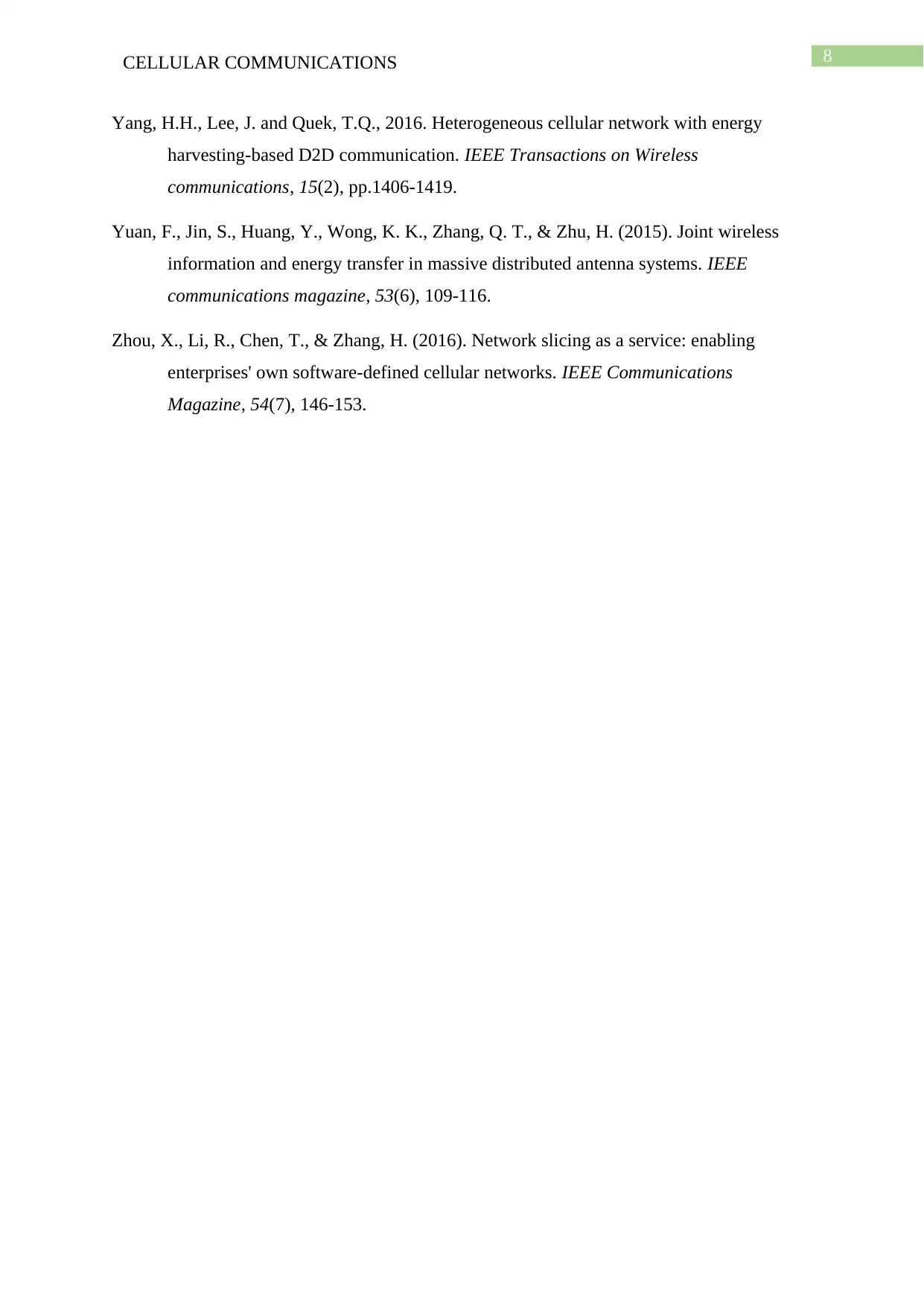
8CELLULAR COMMUNICATIONS
Yang, H.H., Lee, J. and Quek, T.Q., 2016. Heterogeneous cellular network with energy
harvesting-based D2D communication. IEEE Transactions on Wireless
communications, 15(2), pp.1406-1419.
Yuan, F., Jin, S., Huang, Y., Wong, K. K., Zhang, Q. T., & Zhu, H. (2015). Joint wireless
information and energy transfer in massive distributed antenna systems. IEEE
communications magazine, 53(6), 109-116.
Zhou, X., Li, R., Chen, T., & Zhang, H. (2016). Network slicing as a service: enabling
enterprises' own software-defined cellular networks. IEEE Communications
Magazine, 54(7), 146-153.
Yang, H.H., Lee, J. and Quek, T.Q., 2016. Heterogeneous cellular network with energy
harvesting-based D2D communication. IEEE Transactions on Wireless
communications, 15(2), pp.1406-1419.
Yuan, F., Jin, S., Huang, Y., Wong, K. K., Zhang, Q. T., & Zhu, H. (2015). Joint wireless
information and energy transfer in massive distributed antenna systems. IEEE
communications magazine, 53(6), 109-116.
Zhou, X., Li, R., Chen, T., & Zhang, H. (2016). Network slicing as a service: enabling
enterprises' own software-defined cellular networks. IEEE Communications
Magazine, 54(7), 146-153.
⊘ This is a preview!⊘
Do you want full access?
Subscribe today to unlock all pages.

Trusted by 1+ million students worldwide
1 out of 9
Related Documents
Your All-in-One AI-Powered Toolkit for Academic Success.
+13062052269
info@desklib.com
Available 24*7 on WhatsApp / Email
![[object Object]](/_next/static/media/star-bottom.7253800d.svg)
Unlock your academic potential
© 2024 | Zucol Services PVT LTD | All rights reserved.





